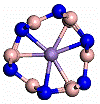Department of Physics and Astronomy: Publications and Other Research

Stephen Ducharme Publications
Document Type
Article
Date of this Version
12-1986
Abstract
This thesis summarizes the results of experimental investigations of the photorefractive properties of melt-grown BaTiO3 single crystals. Three basic photorefractive material properties are studied: (1) the effective density of photorefractive charges, (2) the photoconductivity of the photorefractive charges, and (3) the relative contributions of electron and hole photoconduction. Volume holographic measurement techniques are used: two-beam energy coupling, four-wave mixing, and erasure of volume holograms. The photorefractive properties were altered experimentally by chemically reducing or oxidizing a BaTiO3 crystal. I have extended the “hopping conduction” model of photorefractive transport to include simultaneous electron and hole photoconduction. The extension of the hopping conduction model also describes all ranges of photorefractive site occupancy as observed in photorefractive crystals. The photorefractive speed, and hence the photoconductivity, is shown experimentally to be sublinear in the optical intensity in contrast to the predictions of existing models of photorefractive transport. A model of the photorefractive sites is proposed to explain the observed changes in the photorefractive properties of BaTiO3 when a crystal is oxidized or reduced. The model postulates that oxygen vacancies produced by reduction combine with iron impurities to form photorefractive donors, and that the remaining iron impurities are the photorefractive acceptors. The model of the photorefractive sites describes the experimental observation that the photorefractive sites switch from acceptor to donor and the photoconductivity from hole- to electron-dominated at the same density of oxygen vacancies as oxygen vacancies are introduced into a BaTiO3 crystal.
The electrooptic and piezoelectric coefficients of BaTiO3 were measured by interferometric techniques and compared to holographic measurements. In addition, a technique for electrical poling of multidomain single crystals of BaTiO3 containing both 90° and 180° domain walls is described.


Comments
A dissertation presented to the Faculty of the Graduate School at the University of Southern California in partial fulfillment of the requirements for the degree Doctor of Philosophy (Physics), December 1986.
Copyright © 1986 Stephen Ducharme